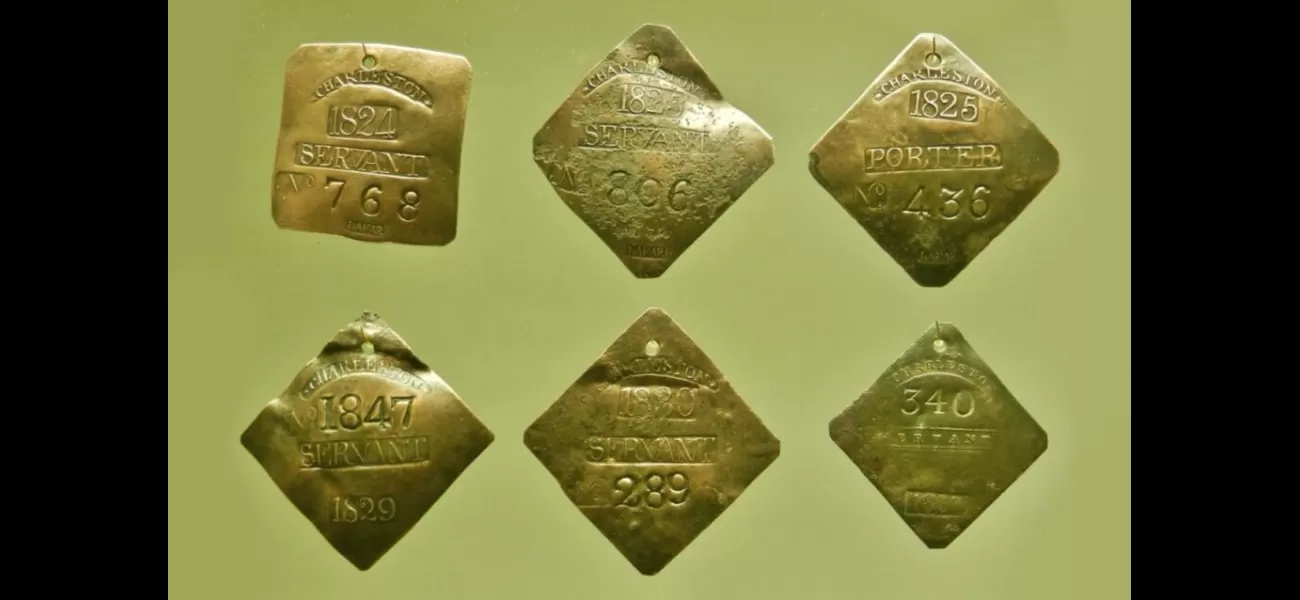Museum gets slave badges for searchable exhibit.
"African American History and Culture Museum to exhibit largest collection of Charleston Slave Badges at Smithsonian."
June 24th 2024.

The Smithsonian's National Museum of African American History and Culture is proud to announce the display of a remarkable collection of historic Charleston Slave Badges, available for viewing through an online search. This collection is an extensive one, boasting 146 rare badges dating back to 1804, some even featuring unique makers' marks and personalized inscriptions. In order to reach a wide audience, the museum has launched a special feature on their website, SearchableMuseum.com/SlaveBadges, which details the significance of these badges and the museum's recent acquisition.
According to Mary Elliott, the museum curator at NMAAHC, this is an opportunity to honor the enslaved African Americans who played a crucial role in building our nation. "Their story is one that highlights the harsh reality of profit and power, and the immense human cost that was paid," she explains. "But it also sheds light on the resilience and strength of these skilled craftspeople, who managed to maintain their humanity and survive the brutal system of slavery, leaving their mark on history in more ways than one."
Through the digital exhibit, visitors can interact with the artifacts and delve into the complex system of leased enslaved labor that was prevalent in Charleston, South Carolina. It also explores the various ways in which enslaved African Americans utilized their skills, intelligence, and abilities to navigate the horrors of slavery. This new Searchable Museum feature offers valuable insights into collecting, archaeology, vocational training, and the concept of freedom, in addition to providing a comprehensive history of Charleston Slave Badges.
The Charleston Slave Badge system was established in 1783, and it was primarily used as a means of control and profit for the enslavers. Enslaved individuals were leased out by their owners and were required to wear registered badges that identified their occupation, whether as skilled craftsmen or servants. This system imposed strict surveillance and severely limited their autonomy within the city while they were working. Today, these badges serve as poignant reminders of the immense skill and contributions of enslaved people in building the city of Charleston.
This was a legal system that involved both the enslavers and the city government. Enslavers paid a registration fee to the city for each enslaved person whose labor they leased out. In return, the city issued badges, typically made of copper, that identified these leased laborers. This arrangement proved to be lucrative for the enslavers, who profited from leasing out the skills of African Americans. At the same time, the city also benefited economically and from the skilled labor that played a significant role in shaping Charleston's urban development.
Interestingly, those who wore these badges had a degree of freedom to move around the city while working, allowing them to interact with a larger network of enslaved individuals. In some cases, they even retained a portion of their earnings and were able to use it to secure their freedom and that of their families.
This impressive collection was compiled by Harry S. Hutchins Jr., a well-known collector who worked alongside co-authors Brian E. Hutchins and historian Harlan Greene to write and publish the book, "Slave Badges and the Slave Hire System in Charleston, South Carolina, 1783–1865." In his credit line for the collection, Hutchins dedicates it to the individuals represented by these Slave Hire Badges and their descendants, making it a powerful tribute to the resilience and strength of those who were enslaved in Charleston.
According to Mary Elliott, the museum curator at NMAAHC, this is an opportunity to honor the enslaved African Americans who played a crucial role in building our nation. "Their story is one that highlights the harsh reality of profit and power, and the immense human cost that was paid," she explains. "But it also sheds light on the resilience and strength of these skilled craftspeople, who managed to maintain their humanity and survive the brutal system of slavery, leaving their mark on history in more ways than one."
Through the digital exhibit, visitors can interact with the artifacts and delve into the complex system of leased enslaved labor that was prevalent in Charleston, South Carolina. It also explores the various ways in which enslaved African Americans utilized their skills, intelligence, and abilities to navigate the horrors of slavery. This new Searchable Museum feature offers valuable insights into collecting, archaeology, vocational training, and the concept of freedom, in addition to providing a comprehensive history of Charleston Slave Badges.
The Charleston Slave Badge system was established in 1783, and it was primarily used as a means of control and profit for the enslavers. Enslaved individuals were leased out by their owners and were required to wear registered badges that identified their occupation, whether as skilled craftsmen or servants. This system imposed strict surveillance and severely limited their autonomy within the city while they were working. Today, these badges serve as poignant reminders of the immense skill and contributions of enslaved people in building the city of Charleston.
This was a legal system that involved both the enslavers and the city government. Enslavers paid a registration fee to the city for each enslaved person whose labor they leased out. In return, the city issued badges, typically made of copper, that identified these leased laborers. This arrangement proved to be lucrative for the enslavers, who profited from leasing out the skills of African Americans. At the same time, the city also benefited economically and from the skilled labor that played a significant role in shaping Charleston's urban development.
Interestingly, those who wore these badges had a degree of freedom to move around the city while working, allowing them to interact with a larger network of enslaved individuals. In some cases, they even retained a portion of their earnings and were able to use it to secure their freedom and that of their families.
This impressive collection was compiled by Harry S. Hutchins Jr., a well-known collector who worked alongside co-authors Brian E. Hutchins and historian Harlan Greene to write and publish the book, "Slave Badges and the Slave Hire System in Charleston, South Carolina, 1783–1865." In his credit line for the collection, Hutchins dedicates it to the individuals represented by these Slave Hire Badges and their descendants, making it a powerful tribute to the resilience and strength of those who were enslaved in Charleston.
[This article has been trending online recently and has been generated with AI. Your feed is customized.]
[Generative AI is experimental.]
0
0
Submit Comment





